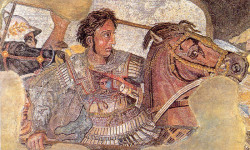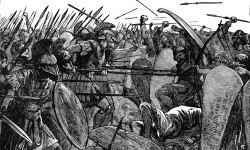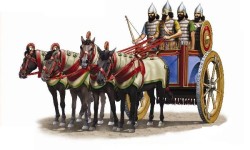The first historically documented wars between organized forces took place around the year 3000 to 2500 BC between the Sumerian city-states in today's area around Israel, Syria, Jordan and Iraq.
Even the largest of these states could set up a small army only for short campaigns to go to war. The armies were composed for the most part of helmeted foot soldiers with spears, accompanied by noble warriors and archers with slow carts on disc wheels.
The main reason for the early disputes were on the one hand disputes over territories or over water supplies. A number of inscriptions found, including those on the so-called Geierstele, tell of conflicts between the city of Lagash and its neighbor Umma in the period around 2500 BC. The inscriptions show how the ruler of Lagash marches "Eannatum" at the head of his infantry. The inscriptions continue to tell that despite an injury to Eannatum by an arrow, this one has emerged successfully from the battle.
To take the image of the stele, the joy of the victory on the part of Lagasch seemed to have been very great, scavengers adorn the picture when taking the dead.
The kingdom of Akkad
According to a later report on the city Lagasch, this pursued a pronounced warlike conflict with the environment. Thus, reports of wide conflicts were discovered as far as the distant Elam in western Iran.
However, when these conflicts were still carried out in terms of water supply or dispute resolution, this changed around 2300 BC in the campaigns of Sargon of Akkad. Through these campaigns, war served for the first time for the establishment of the empire and the incorporation of other areas and cities. The city of Kish, north of Lagash, soon fell victim to the kingdom of Akkad. From there, he expanded his sphere of influence beyond the other city states of Mesopotamia to the Persian Gulf. Further expansion towards the Syrian Mediterranean coast and eastern Anatolia followed. According to the traditional inscriptions Akkad had a standing army of around 5400 men and decided in his 40-year rule 34 battles.
After the demise of Sargon, his created empire continued to exist for another 100 years and expanded to its last ruler, Sargon's grandson Naram-Sin, to the Taurus in the north and the Persian Gulf in the south. It was not until about 1760 BC that the Akkadian troops were defeated by the Babylonian King Hammurabi and that the empire was incorporated into the Babylonians.
Kingdom of the pharaohs
In addition to the Babylonian expansion, warfare also developed in Egypt at about the same time as the expansion of the empire. In the period of the Middle Egyptian Empire from 2040 to 1785 BC, the ruling pharaohs led campaigns into Nubia, south of Egypt, and built a series of fortresses and defenses to claim their new territory and defend them against enemies. In the period of the new Egyptian Empire from 1750 BC, the expansion was intensified. The scribes of Pharaoh's Thutmose III. , ruler of Egypt from 1479 to 1425 BC, reported on 17 campaigns that took place over other parts of Nubia and on today's Syria.
Based on the reports made, many of the ancient Egyptian campaigns can still be reconstructed today. So today one can still trace the campaigns against principalities in Palestine around 1460 BC, in which, for example, by a surprise attack of the Egyptians the city Megiddo fell. The battles over the rule of Syria and Lebanon could be reconstructed on the basis of the Scriptures. These also mention the first closed peace treaty between Egypt and Hittites, which was concluded around 1275 BC.
In the period around 1176 BC, the first naval battle was also documented when attackers were repulsed by Egyptian soldiers on river barges in the Nile Delta.
You can find the right literature here:
Sumerians: A Captivating Guide to Ancient Sumerian History, Sumerian Mythology and the Mesopotamian Empire of the Sumer Civilization

Sumerians: A Captivating Guide to Ancient Sumerian History, Sumerian Mythology and the Mesopotamian Empire of the Sumer Civilization Paperback – May 2, 2018
The sheer importance of Sumerian culture in regards to world culture as a whole is impossible to overstate. This civilization is single-handedly responsible for some of the most major innovations in nearly every field relevant to maintaining a civilized society - this includes religion, lawmaking, architecture, schooling, art, literature, and even entertainment.
Naturally, most of what we see as negative aspects of society were established in Ancient Sumer as well. There wasn’t an aspect of Sumerian life that wasn’t plagued with corruption or devastation of one form or another. In other words, the Sumerians gave us both the sublimeness of faith and the rigidness of religious thought coupled with a desire for political supremacy. They gave us both the benevolent, caring monarchs and cruel, punishing tyrants; the educated child and the spoiled brat; the hard-working agrarian and the drunken reveler; and the epic empires as well as the pathetic remnants of them. The Sumerians did it all, and they did it first.
Sumerians: A History From Beginning to End
A legendary civilization vanished under the Fertile Crescent and escaped a fate worse than death until Sumerologists questioned widely accepted truths. The Sumerians reemerged onto the extraordinary timeline of human history. Their tales of kings and gods, including the Epic of Gilgamesh, and their fearless trade in distant lands, during the remarkable Bronze Age, centered in the world’s first city-states that chronicled ancient rivalries and their enduring impact.
Sumer: The History of the Cities and Culture that Established Ancient Mesopotamia’s First Civilization

Sumer: The History of the Cities and Culture that Established Ancient Mesopotamia’s First Civilization Paperback – March 26, 2018
When American archaeologists discovered a collection of cuneiform tablets in Iraq in the late 19th century, they were confronted with a language and a people who were at the time only scarcely known to even the most knowledgeable scholars of ancient Mesopotamia: the Sumerians. The exploits and achievements of other Mesopotamian peoples, such as the Assyrians and Babylonians, were already known to a large segment of the population through the Old Testament and the nascent field of Near Eastern studies had unraveled the enigma of the Akkadian language that was widely used throughout the region in ancient times, but the discovery of the Sumerian tablets brought to light the existence of the Sumerian culture, which was the oldest of all the Mesopotamian cultures.
Although the Sumerians continue to get second or even third billing compared to the Babylonians and Assyrians, perhaps because they never built an empire as great as the Assyrians or established a city as enduring and great as Babylon, they were the people who provided the template of civilization that all later Mesopotamians built upon. The Sumerians are credited with being the first people to invent writing, libraries, cities, and schools in Mesopotamia (Ziskind 1972, 34), and many would argue that they were the first people to create and do those things anywhere in world.
For a people so great it is unfortunate that their accomplishments and contributions, not only to Mesopotamian civilization but to civilization in general, largely go unnoticed by the majority of the public. Perhaps the Sumerians were victims of their own success; they gradually entered the historical record, established a fine civilization, and then slowly submerged into the cultural patchwork of their surroundings. They also never suffered a great and sudden collapse like other peoples of the ancient Near East, such as the Hittites, Assyrians and Neo-Babylonians did. A close examination of Sumerian culture and chronology reveals that the Sumerians set the cultural tone in Mesopotamia for several centuries in the realms of politics/governments, arts, literature, and religion.
Even today, the world owes the Sumerians a tremendous amount. When Western Europe was still in the Stone Age, it was the Sumerians who invented writing and the wheel, divided time into minutes and seconds, tamed nature, and built gigantic cities. They embraced culture and the arts, and their caravans crossed the desert, opening up the first trade routes. Their myths and legends inspired various origin stories, and their memory lives on in the Old Testament. They wrote the history of the birth of mankind. The heritage of the Sumerian civilization and their successors is everywhere.
Sumer: The History of the Cities and Culture that Established Ancient Mesopotamia’s First Civilization chronicles the most important people, places, and events that took place across Sumer. Along with pictures of important people, places, and events, you will learn about Sumer like never before.
History Begins at Sumer: Thirty-Nine Firsts in Recorded History
Which civilization had the first system of law? The first formal educational system? The first tax cut? The first love song? The answers were found in excavations of ancient Sumer, a society so developed, resourceful, and enterprising that it, in a sense, created history. The book presents a cross section of the Sumerian "firsts" in all the major fields of human endeavor, including government and politics, education and literature, philosophy and ethics, law and justice, agriculture and medicine, even love and family.
History Begins at Sumer is the classic account of the achievements of the Sumerians, who lived in what is now southern Iraq during the third millennium B.C. They were the developers of the cuneiform system of writing, perhaps their greatest contribution to civilization, which allowed laws and literature to be recorded for the first time.
This post is also available in:
 Deutsch (German)
Deutsch (German)  Français (French)
Français (French)  Italiano (Italian)
Italiano (Italian)  简体中文 (Chinese (Simplified))
简体中文 (Chinese (Simplified))  Русский (Russian)
Русский (Russian)  Español (Spanish)
Español (Spanish)  العربية (Arabic)
العربية (Arabic)



















